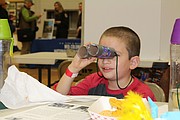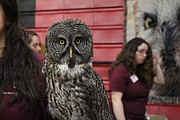Sandhill Crane Festival draws crowds
OTHELLO — Birdwatchers and people interested in nature and the outdoors took advantage of a sunny Saturday to fill the Othello High School gym and fan out through the region as part of the 20th annual Sandhill Crane Festival.
Events also were scheduled on Friday and Sunday, mostly tours to birdwatching sites and to spots with interesting habitat and geological history. “It’s pretty amazing for a community of this size to put on something like this for 20 years,” said Scott Petersen, Anacortes, making his fourth trip to the festival.
Mike Lascala of Seattle is a self-described “bird follower” who was making his second trip to the festival. “It was a lot of fun the first time. It’s such a mix – the birds, the geology, the human history.”
Sandhill cranes and other birds that live in and pass through the Columbia Basin are the focus of the festival. Birdwatchers get a chance to take to the Potholes in boats, tour the area around Othello by bus and bicycle, and take bus tours of the Columbia National Wildlife Refuge, Wahluke Slope, Lower Crab Creek and other ornithological hot spots.
Tours of interesting local geology are mixed in, and there’s a trip to the Hanford Reach Interpretive Center, as well as an active site where paleontologists are digging for mammoth bones. Saturday also included a full day of lectures, on birds, native plants and ecosystems, wildlife photography, even reminiscences from a veteran birdwatcher.
“A bevy of quality speakers – how about a flock of quality speakers?” Petersen said.
The Raptor Club from Washington State University brought some of the eagles, hawks and owls it keeps on campus. All were injured or had some form of birth defect, and couldn’t survive in the wild.
The Columbia Basin is a stop for migrating birds like sandhill cranes, and a home for raptors, songbirds and ground species like quail. “We’ve already seen some really interesting raptors,” Lascala said Saturday afternoon. “My wife has already made an addition to her life list.” (For those who are not birdwatchers, life lists are records of the birds birdwatchers have watched throughout their birdwatching careers.)
“The sandhill cranes are the big draw,” Peterson said, but as a geology professor he was interested in the regional geology too. Geologically inclined attendees found plenty to talk about and learn, from the floods of the Ice Age to the volcanic flows that caused the course of rivers to change.
Cheryl Schweizer can be reached via email at [email protected].





